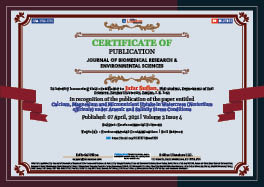Jafar Sufian*, Ahmad Golchin and Arman Avanes
Volume2-Issue4
Dates: Received: 2021-03-29 | Accepted: 2021-04-06 | Published: 2021-04-07
Pages: 251-255
Abstract
Heavy metals are elements that mainly have a 5-22 gr.cm-3 specific gravity. Some of these metals are essential micronutrients for plant growth (Such as Zinc (Zn), Copper (Cu), Manganese (Mn), Nickel (Ni) and Cobalt (Co)). Some other heavy metals, have a high toxicity properties such as Lead (Pb), Cadmium (Cd) and Mercury (Hg). In order to investigate the potential of watercress (Nasturtium officinale) in the uptake of elements from nutrient solutions with different salinities, a factorial experiment was conducted in a completely randomized design with three replications in the greenhouse. In this experiment, different levels of arsenic were zero, 5, 10, 20, 40, 40, 80 and 160 mg.L-1, which were obtained from sodium arsenate source and added to Epstein’s nutrient solution to obtain the mentioned concentrations. The salt concentration of the nutrient solution was 0, 10, 20, 40 and 80 mM which was prepared from sodium chloride source and added to Epstein solution. After making nutrient solutions with different salinity and concentrations, watercress was cultivated. The ANOVA results showed that the interaction of salinity and arsenic levels on the calcium, magnesium, iron, manganese, zinc and copper concentrations in watercress was significant at the level of one percent probability. The highest concentrations of these elements were obtained in the levels without salinity and arsenic and the lowest values were obtained in the 80 mM salinity levels and 160 mg.l-1 arsenic.
FullText HTML
FullText PDF
DOI: 10.37871/jbres1220
Certificate of Publication

Copyright
© 2021 Sufian J, et al. Distributed under Creative Commons CC-BY 4.0
How to cite this article
Sufian J, Golchin A, Avanes A. Calcium, Magnesium and Micronutrient Uptake in Watercress (Nasturtium officinale) under Arsenic and Salinity Stress Conditions. J Biomed Res Environ Sci. 2021 Apr 07; 2(4): 251-255. doi: 10.37871/jbres1220, Article ID: jbres1220
Subject area(s)
References
- Howard HW. Watercress Rorippa nasturtium-aquaticum (Cruciferae). In: Evolution of crop plants. N.W. Simmonds (ed.). Longman, London. 1976;62-64. https://bit.ly/3rUzM2I
- Palaniswamy UR, McAvoy RJ. Watercress: A salad crop with chemopreventative potential. Hort Technology. 2001;11(4):622-626. https://bit.ly/3cTvIfa
- Kabata-Pendias A, Pendias H. Trace elements in soils and plants. Boca Raton, FL: CRC Press. 2001.
- Gupta VK, Shrivastava AK, Jain N. Biosorption of chromium (VI) from aqueous solutions by green algae Spirogyra species. Water Res. 2001;35:4079-4085. https://bit.ly/2R9QkY6
- Agency for Toxic Substances and Disease Registry (ATSDR). Toxicological profile for arsenic (Update). Atlanta, GA: U.S. Department of Health and Human Services, Public Health Service. 2000.
- Bissen M, Frimmel FH. Arsenic-a review. Part I: Occurrence, toxicity, speciation, mobility. Acta Hydrochim. Hydrobiol. 2003;31:9-18. https://bit.ly/3ulb79a
- Oram B, Halsor S, Redmond B. Water quality. Wilkes University Center for Environmental Quality Environmental Engineering and Earth Sciences (Wilkes-Barre, PA) 2010.
- Rajpar I, Jandan I, Hassan Z, Jamro GM, Shah AN. Enhanced fodder yield of maize genotypes under saline irrigation is a function of their increased K accumulation and better K/Na ratio. Afr J Biotech. 2011;10:1559-1565. https://bit.ly/3dBs7BA
- Parida AK, Das AB. Salt tolerance and salinity effects on plants: A review. Ecotoxicol Environ Saf. 2005 Mar;60(3):324-49. doi: 10.1016/j.ecoenv.2004.06.010. PMID: 15590011.
- Paital B, Chainy GB. Antioxidant defenses and oxidative stress parameters in tissues of mud crab (Scylla serrata) with reference to changing salinity. Comp Biochem Physiol C Toxicol Pharmacol. 2010 Jan;151(1):142-51. doi: 10.1016/j.cbpc.2009.09.007. Epub 2009 Sep 29. PMID: 19796708.
- Paital B, Chainy GB. Effects of salinity on O consumption, ROS generation and oxidative stress status of gill mitochondria of the mud crab Scylla serrata. Comp Biochem Physiol C Toxicol Pharmacol. 2012 Mar;155(2):228-37. doi: 10.1016/j.cbpc.2011.08.009. Epub 2011 Sep 10. PMID: 21930243.
- Bal A, Panda F, Pati SG, Das K, Agrawal PK, Paital B. Modulation of physiological oxidative stress and antioxidant status by abiotic factors especially salinity in aquatic organisms. Comp Biochem Physiol C Toxicol Pharmacol. 2021 Mar;241:108971. doi: 10.1016/j.cbpc.2020.108971. Epub 2021 Jan 6. PMID: 33421636.
- Hayashi H, Murata N. Genetically engineered enhancement of salt tolerance in higher plants Molecular Mechanisms and Molecular Regulation, Elsevier; Amsterdam. 1998;133-148.
- Leblebtect Z, Akosy A, Duman F. Influence of salinity on the growth and heavy metal accumulation capacity of Spirodela polyrrhiza. Turk J Biol. 2009;35:215-220. https://bit.ly/3dAo2gV
- Marschner H. Mineral Nutrition of Higher Plants, second ed. Academic Press Limited, London, UK; 1995. https://bit.ly/3sUCy9I
- Carbonell AA, Aarabi MA, Delaune RD, Gambrell RP, Patrick Jr WH. Arsenic in wetland vegetation: Availability, phytotoxicity, uptake and effects on plant growth and nutrition. The Science of the Total Environment. 1998;217:189-199. https://bit.ly/3sXQ3W0
- Carbonellâ€Barrachina AA, Burloâ€Carbonell F, Mataixâ€Beneyto J. Effect of sodium arsenite and sodium chloride on bean plant nutrition (Macronutrients). Plant Nutri. 1997;20:1617â€1633. https://bit.ly/3sXU3pB
- Rio S, Parveen Z, Imamul Huq SM. Effect of arsenic on the pattern of Amaranthus. Dhaka Univ. J Biol Sci. 2012;21(1):87â€96.
- Shaibur MR, Kitajima N, Sugawara R, Kondo T, Huq SMI, Kawai S. Physiological and mineralogical properties of arsenicâ€induced chlorosis in barley seedlings grown hydroponically. Plant Nutri. 2008;31:333â€353. https://bit.ly/39NiA9f
- Tu C, Lena Q, Ma LQ. Effects of arsenic on concentration and distribution of nutrients in the fronds of the arsenic hyperaccumulator Pteris vittata L. Environmental Pollution. 2005;135:333-340. https://bit.ly/3rNTOfq
- Abdel-Sabour MF, Mortvedt JJ, Kelson JJ. Cadmium-Zinc interaction in plants and extractable cadmium and zinc fractions in soil. Soil Sci. 1988;145(6):426-431. https://bit.ly/3dDr8kb